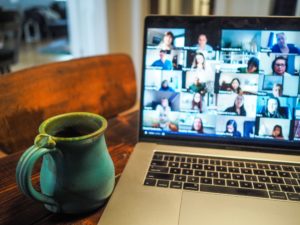When CDC guidelines came out in March, discouraging groups of 10 or more from meeting in person, many of DBSA’s 500+ support groups across the country weren’t sure how to move forward. But weeks later, hundreds of local groups that usually meet face-to-face have moved to online platforms so that peers can stay in touch.
In San Francisco, DBSA support groups quickly moved from St. Francis Memorial Hospital to a local coffee shop, then jumped on Zoom, says Anne Lyse Meffre, a board member with the DBSA San Francisco chapter.
“We’ve gone from seeing 15 to 25 adults in our general support group to more than 40, twice a week,” Meffre says. “We use two breakout rooms each time, doubling the air time so we can welcome more people.” The chapter’s family-and-friends support group has also moved to Zoom.
Newcomers are finding their way to both groups – and people who moved out of the city have returned, too. “We have people coming from as far away as Thailand,” Meffre says.
“According to science, bottling up emotions only strengthens them,” she notes, “but meeting online gives people the chance to express their emotions and get feedback. This reappraisal, or taking a broader perspective, is one of the best ways we can regulate our emotions, improve relationships and feel happier.”
Facilitators often leave the lines open at the end of meetings so people can hang out, Meffre adds. “Social connection boosts health, even when you’re in different physical spaces. It gives everyone a sense of community, just being together.”
The life-changing benefits of connection
In Greenwich, Connecticut, facilitators have expanded a once-weekly support group to 5 virtual meetings, says DBSA chapter founder Dr. John Tamerin.
“We’re reaching a much wider radius, since people don’t have to travel,” Dr. Tamerin explains. “People also enjoy the convenience of joining for a short time, or staying for the full meeting.”
As a retired psychiatrist, Dr. Tamerin says that online support is making a lifesaving difference.
“All our members are doing well,” he reports. “No huge increase in anxiety or depression. No massive increases in medications, no hospitalization, no increase in suicidal ideation. This shows how support groups provide community, caring, wisdom, accountability and techniques … our group is like a shelter from the storm.”
Peer support groups boost confidence, optimism, and hope
For 35 years, DBSA support groups have served as a lifeline for thousands. There’s nothing like the experience of meeting with peers who are willing to freely share their experiences and coping strategies.
A Pepperdine University study showed that peers who attended DBSA’s online support groups felt significantly better informed, more accepting of their mental health condition, confident about their treatment and optimistic about their control over the future. During COVID-19, benefits like these are especially crucial for people with mood disorders and for caregivers, friends, and families.
How to find a local support group
Around 65% of all local DBSA support groups have moved online. Our national team is working to help even more chapters and support groups find virtual meeting platforms that work for them. Some chapters have added special offerings such as yoga, cooking classes and webinars on mental health topics.
To find the group nearest you, click here. And if you don’t find a group nearby, check out our 12 national support groups, which you can join from anywhere in the country.


